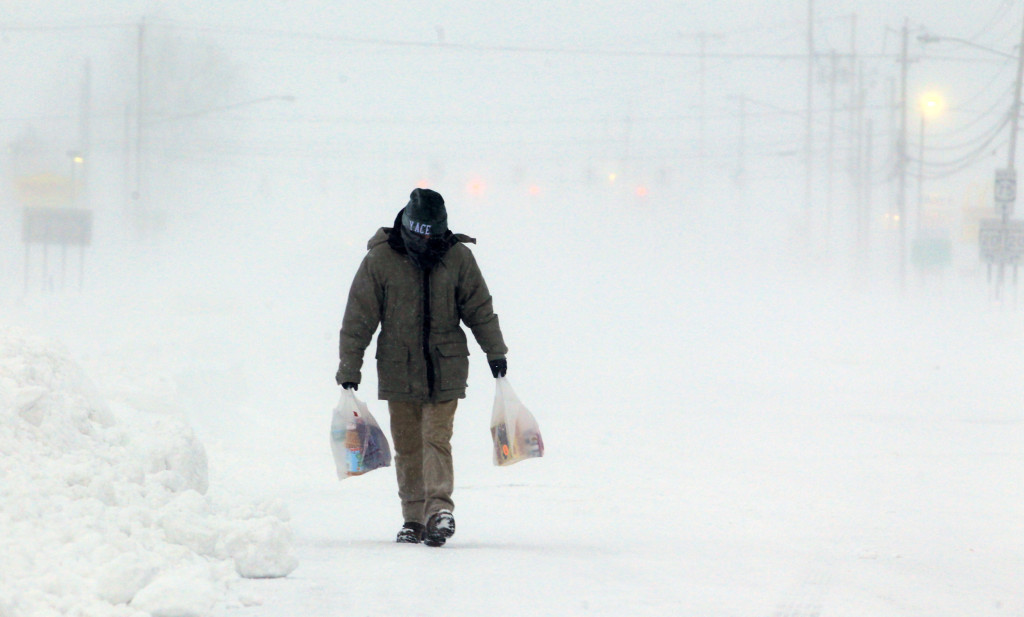Look at images of much of the United States east of the Rocky Mountains over the last few weeks and what you’ll see is reminiscent of a scene from Disney’s “Frozen,” albeit with less singing and more fatalities.
It’s nearly impossible to find an area of the U.S. that has not been affected by the freezing temperatures that have spread across the Northern Hemisphere. This winter freeze, caused by what scientists call the polar vortex, has caused dramatic temperature changes in over two dozen states.
Americans who haven’t directly experienced these freezing temperatures have probably felt the effects of the freeze through canceled and delayed flights, as well as the political stir that the temperature change has ignited.

Lucas Hunter from Pittsburgh walks to his hotel along Camp Road in Hamburg, N.Y. after a stretch of the New York State thruway was closed down due to high winds Tuesday, Jan. 7.
The latest reports estimate that total damage from the storm has cost the U.S. economy around $5 billion. The storm altered all aspects of life for those affected. The homeless are among some of the hardest hit.
“How we’re dealing with it? You can’t deal with it,” said John Tyler, a self-described homeless man from Kentucky, as quoted by the Seattle Times.
Tyler and his friends gathered in a McDonald’s to keep safe from the storm.
A recent New York Times blog post published last Monday reported many extreme effects of the polar vortex. Minneapolis reached 15 degrees below zero and North Dakota reached 23 below zero, but the severity of the cold is more accurately depicted by wind chill temperatures. Wind chills reached 50 to 60 degrees below zero in the six worst states, giving residents more than enough reason to stay home and take every precaution to stay safe and warm.
The New York Times noted that “exposed skin freezes within 10 minutes of wind chill temperatures of 35 degrees below zero or colder.” That means that for residents of affected states, even a quick trip outside can be a serious danger.
Even warnings and instructions from the government couldn’t prevent the worst effects of the vortex. According to CNN, over 23 deaths were reportedly caused by the freezing weather. Additional damage included bursting pipes, damage to houses and businesses, and flooded streets.
The New York Times reported that 2,500 flights have been canceled due to the weather and the governor of Minnesota shut down public schools for the first time in 17 years. The mayor of Indianapolis went so far as to ban driving. Iowa, Minnesota, North and South Dakota, and Wisconsin were among the hardest hit states.
Since temperatures began to climb back to normal last Tuesday, the news surrounding the polar vortex took on a different tone. A debate on whether or not these freezing temperatures disprove global warming escalated quickly this week, with the Obama Administration trying to use the polar vortex in support of climate change and many conservatives attempting to use the same polar vortex as evidence against the phenomenon.
“Confronted with the embarrassment of historic cold gripping the nation just as the Obama administration launches a new offensive on the mythical global warming crisis, global warming activists and their media allies just invented their most knee-slapping assertion yet; that global warming causes winter cold outbreaks,” reads a statement from Forbes magazine.
The statement from the official White House blog reads as follows: “We know that no single weather episode proves or disproves climate change. Climate refers to the patterns observed in the weather over time and space – in terms of averages, variations, and probabilities. But we also know that this week’s cold spell is of a type there’s reason to believe may become more frequent in a world that’s getting warmer, on average, because of greenhouse-gas pollution.” Last Friday, the White House hosted a publicized conversation among meteorologists and researchers in order to better explain the possible effects of the polar vortex.
Until more research is completed, whether or not this cold spell was caused by climate change and man-made pollution remains debatable. But it’s worth noting that on the other side of the globe, Australia is experiencing an extreme heat wave. According to Slate magazine, 2013 was the hottest year on record with temperatures as high as 125 degrees Fahrenheit. And a 2011 article from NPR emphasizes the difference between global warming and climate change, noting that climate change is a more accurate term that describes a broad range of extreme weather fluctuations.
“The world is not just getting generally warmer, in other words, but climate is getting more extreme, with big temperature swings and more hurricanes and the like,” explains the NPR article. “This growing instability even includes, within the general warming pattern, record cold drops and snowstorms for short periods at a time. Some people want to point to the cold spells as evidence against ‘global warming,’ but they are part and parcel of the trend.”
Regardless of what the extreme cold means for the climate change debate, it is undeniable that the United States is breathing a collective sigh of relief as weather finally begins to return to “normal.”








